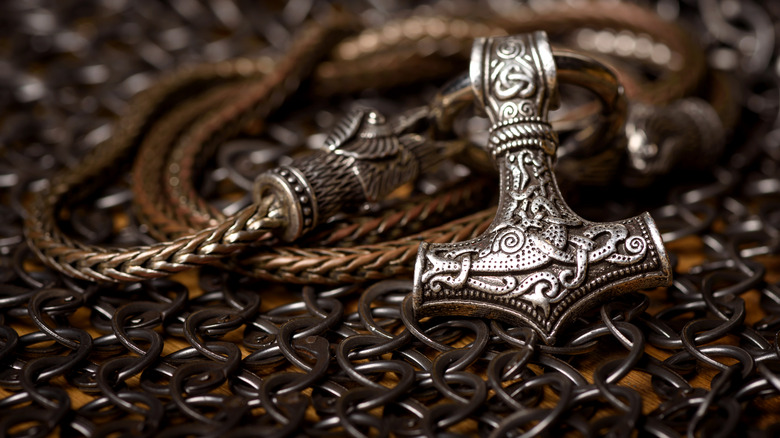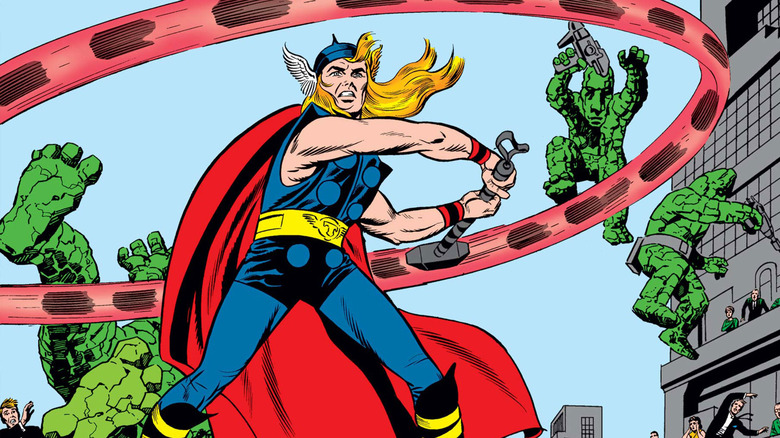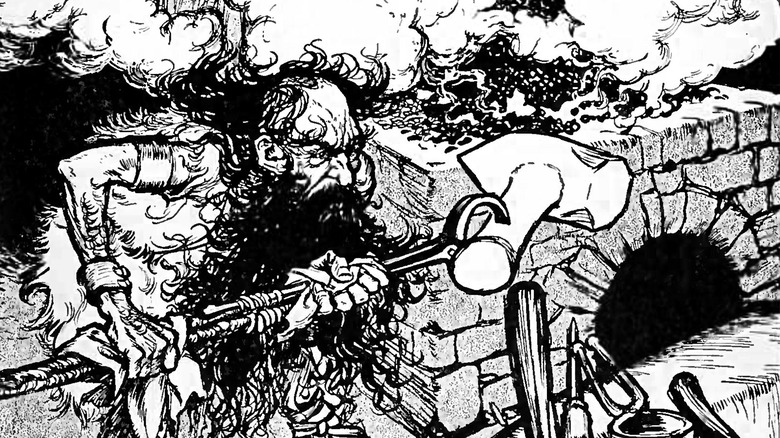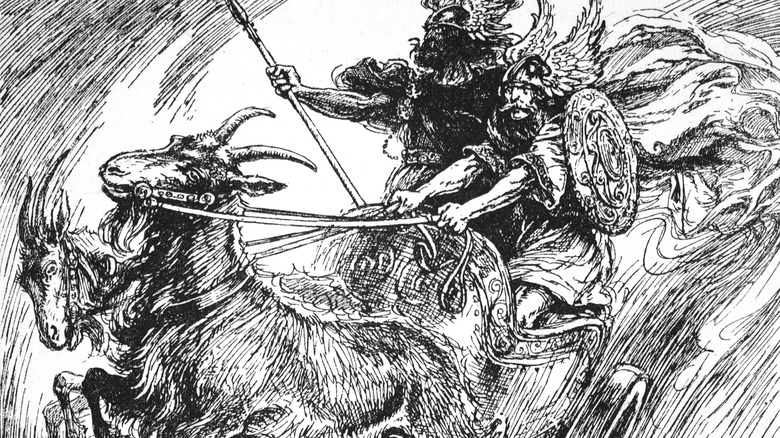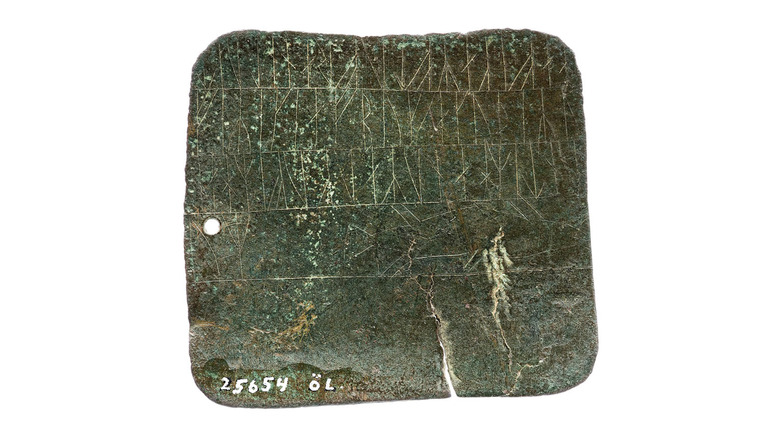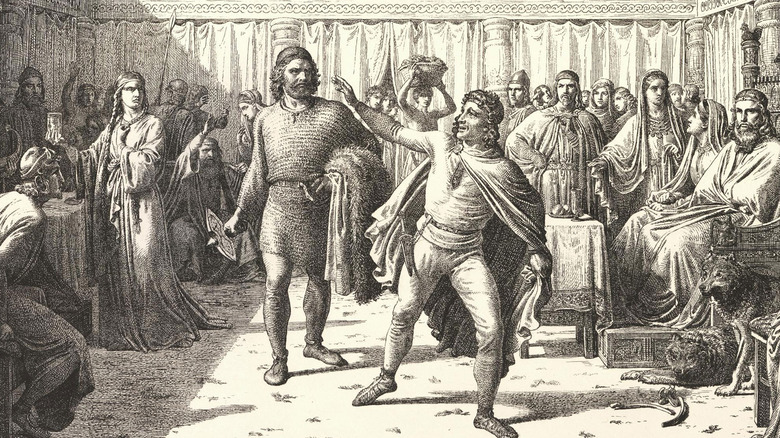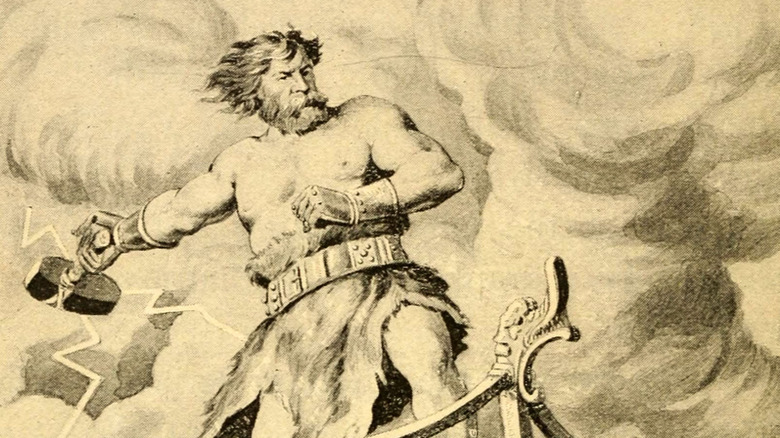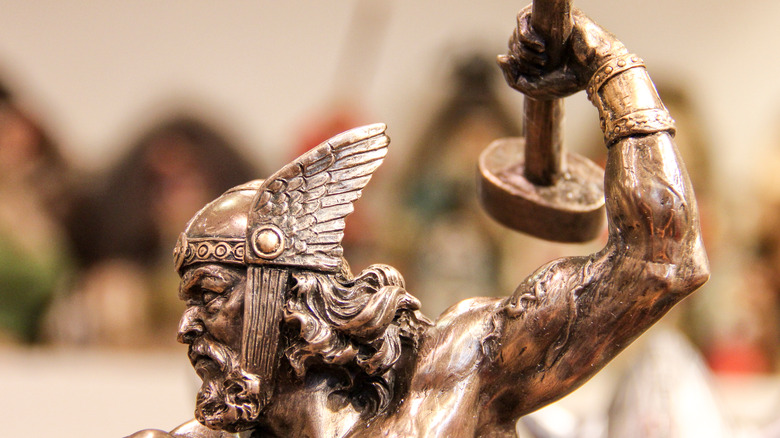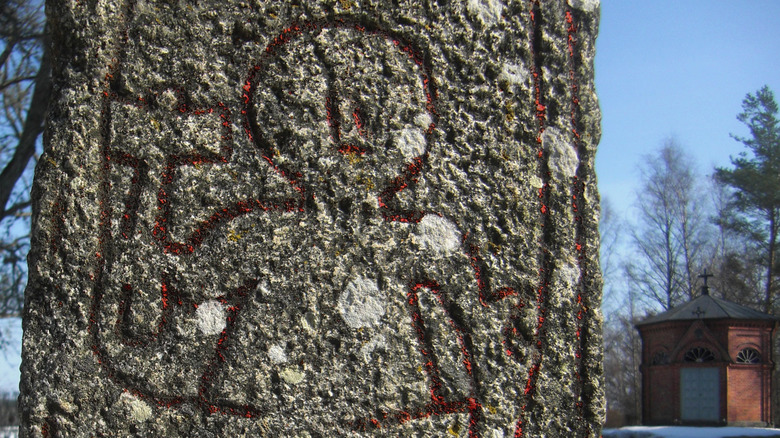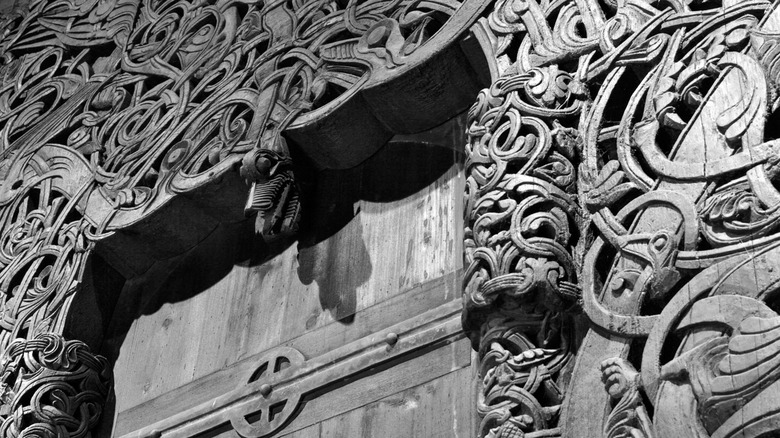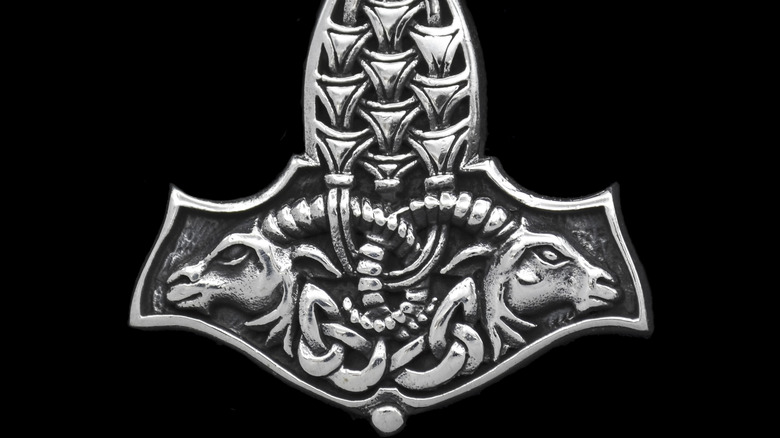The Myth Of Thor's Hammer, Mjölnir, Explained
In Norse mythology, the hammer Mjölnir is every bit as famous as Thor, the thunder god who wields it. The two are so closely tied together that it's hard to find stories about Thor that don't also prominently feature his hammer. And with good reason, too! According to the Online Etymology Dictionary, Thor's name is the same as the Old Norse word for thunder, while Dictionary.com notes that the name Mjölnir relates to an Old Prussian word for lightning. Just as thunder and lightning are inseparable, so too are Thor and Mjölnir in the old Norse legends.
Wielding Mjölnir, Thor is tasked with protecting Asgard, the realm of the gods, and Midgard, the earthly world of humanity. As World History Encyclopedia explains, Mjölnir is just one of three magical items Thor used in his duties, the others being a belt that doubles his strength and a pair of great iron gloves that he needs to wield the hammer. Mjölnir, however, is by far the most famous of these, and it was clearly no less famous in ancient times. The "Prose Edda," a 13th-century compilation of Norse myths, notes how the hammer is particularly well known among the frost giants and mountain giants Thor battles against, explaining, "for with it he has split many a skull." But the stories show Mjölnir as far more than just a weapon. In some tales, it almost seems like a character itself.
Thor in Marvel Comics
In 1962, Marvel Comics published "Journey into Mystery" #83, introducing their newest character, the Mighty Thor. In his first story as a comic book hero, Thor was tasked with defending the Earth, using his hammer Mjölnir to fight against the Stone Men from Saturn. Since then, Thor Odinson has become a popular character in Marvel Comics. His fame has only increased after being featured in a lead role in the Marvel Cinematic Universe movies, where he's played by Chris Hemsworth, particularly with his latest appearances in "Thor: Ragnarok" and "Thor: Blood and Thunder." No less prominent is the hammer Mjölnir.
The comic book version of Mjölnir is different from its mythological counterpart in a few ways. Marvel's version was forged from the heart of a dying star, whereas the original Mjölnir was created from normal iron. Thor's ability to call Mjölnir to him, however, is taken straight from the ancient legends. As Britannica mentions, one of Mjölnir's abilities has always been to return to Thor's hand after being thrown. If anything, the comic version of Thor is actually stronger than the character from mythology. In legend, Thor needed to wear his pair of magical iron gauntlets to be able to wield Mjölnir, being unable to grasp its handle without them. Some stories even showed Thor as being almost powerless without his hammer. In a way, though, this makes perfect sense. After all, thunder can make a deafening noise, but it's the lightning that strikes.
The forging of Mjölnir
The forging of Mjölnir, it turns out, was all a result of Loki and his trickery. The "Prose Edda" recounts the tale "Loki's Wager with the Dwarfs," in which Loki plays a prank on Thor's wife, Sif, by shaving her head. To pacify the enraged Thor, Loki agrees to find a replacement for Sif's hair, and seeks the help of a group of dwarves known as Ivald's Sons. He persuades them to make new hair for Sif, out of gold, as well as a magical ship, Skidbladner, and Gungnir, the spear of Odin. But Loki isn't satisfied without causing some mischief and makes a bet with a dwarf named Brok that his brother, Sindre, can't make another three treasures of the same quality. Taking the bet, Sindre works tirelessly to create three more legendary objects: Freyr's boar Gullinbursti, the magic gold ring Draupnir, and the hammer Mjölnir.
Made of enchanted iron, Mjölnir is given to Thor. It's described as being indestructible, and with the power to always return to its wielder's hand after being thrown. It also has the ability to shrink down small enough to be worn as a pendant against Thor's chest. The only shortcoming, which the dwarves admit, is that it has quite a short handle. The book "The Children of Odin" calls Mjölnir a weapon that only Thor can wield, and mentions that Sindre describes it as "the greatest of the things that I am able to make."
Mjölnir resurrecting Thor's goats
As well as being a fantastically fearsome weapon, Mjölnir also holds the power of life, and Thor could use it to perform blessings. A story about "Thor's Adventures," from the "Prose Edda," begins with Thor setting off on a journey in a chariot pulled by goats. At nightfall, Thor stops to rest at a farm, where he slaughters the goats and makes them into soup. Carefully folding the goat skins, he invites the farmer and his family to eat dinner with him, asking them to leave the bones with the skins when they're done.
The following morning, just before daybreak, Thor takes Mjölnir and uses it to bless the goat skins. Immediately, the goats spring back to life! Unfortunately, Thor sees that one of his goats has a broken leg. Thor is furious with the farmer's family for damaging the bone, but he quells his rage when he sees how terrified they are. In the end, he takes the farmer's children with him as his servants, to atone.
This same story ends with Thor using Mjölnir to battle Jörmungandr, the Midgard Serpent. As World History Encyclopedia notes, Jörmungandr is an impossibly big adversary, large enough that his body encircles the entire world while holding his tail in his mouth. Thor very nearly defeats the serpent before it escapes. Whether Thor attempting to battle it with Mjölnir is a show of Mjölnir's strength or Thor's hubris isn't elaborated upon.
The Kvinneby amulet
Thor and Mjölnir were essentially inseparable in Norse thought, and to call on Thor for aid was also to call on Mjölnir. One prominent reference is in a protective amulet discovered in Öland, Sweden, known as the Kvinneby amulet. It's a small copper charm bearing the image of a fish, intended to be worn. As "The Routledge History of Medieval Magic" mentions, it has a runic inscription that references the tale of Thor fishing for the Midgard Serpent. Another book, "Runic Amulets and Magic Objects," explains that the inscription is written in decorative runic text, and specifically mentions not just Thor but also Mjölnir. Intended to keep the wearer safe from harm, one line of the amulet reads, "may Thor protect him with that hammer." This shows how these stories found their way into daily life in Ancient Scandinavia, but it also highlights Mjölnir's importance.
It's noteworthy that the Kvinneby Amulet specifically mentions Mjölnir because, while other deities also have famous magical weapons, they aren't usually given the same level of prominence. One example is an artifact described by the blog Irish Archaeology, an amulet to Odin discovered at a site in Denmark. Made from a human skull fragment, it has a runic inscription asking for Odin's protection. This amulet, however, makes no mention of Odin's spear Gungnir.
Thor is in no mood for Loki's insults
One story mentions Mjölnir almost as a character in its own right. The "Lokasenna" is a comedic poem from "The Poetic Edda," in which Loki repeatedly taunts the other gods and they fail to get back at him. This is known as a flyting, a competition of exchanged insults. As a witty trickster with a silver tongue, it's the kind of battle at which Loki excels, with no one able to match him. As World History Encyclopedia explains, the tale is intended to entertain, bringing the gods down to Earth, figuratively speaking, and showing their flaws. It's likely the story may even have been dramatically performed. One thing the "Lokasenna" highlights, though, is how Loki respects, or possibly fears Mjölnir.
Thor arrives late to the party and, known for his strength but not his wit, refuses to try to outsmart Loki. Instead, he repeatedly issues the threat, "Unmanly one, cease, or the mighty hammer Mjölnir shall close thy mouth." Thor specifically threatens Loki with Mjölnir, mentioning the hammer's previous victims for dramatic effect. Loki eventually concedes, with the line, "before thee alone do I now go forth, for thou fightest well, I think." Clearly, Loki thinks better of provoking Thor too much, especially when threatened with Mjölnir. It's a testament to his respect for the weapon, perhaps, especially when he'd previously been quite happy to fling his taunts at all of the other gods –- including Odin, the king of Asgard himself.
Thor's duel with Hrungnir
No story shows Mjölnir's power as a weapon quite like Thor's fight against Hrungnir, a giant, known in Norse mythology as a Jötun. The book "Stories from Northern Myths" recounts the tale, in which Hrungnir finds himself as a guest in Asgard. Protected by the laws of hospitality, Hrungnir joins the gods for a feast and, as he eats and drinks, he starts to become increasingly boastful and unruly. He angers the gods, but he continues to insult them, eventually claiming that he'd kill them all and take the goddesses Freyja and Sif as his wives. Having had enough of the giant's insolence, Thor accepts Hrungnir's challenge to a duel. Needless to say, it does not end well for the giant.
In the confrontation, Hrungnir is wielding a flintstone as a weapon, facing Thor and Mjölnir. A strike from Mjölnir breaks the flint into two, with half of it being large enough to form the flint mountains. Immediately afterward, Mjölnir kills the giant with a single blow to the head. The version of the story in the "Prose Edda" states quite graphically how Mjölnir "crushed [Hrungnir's] skull in small pieces." The dead giant then falls onto Thor, who struggles to free himself. It's a testament to how powerful Mjölnir is, that it so easily defeats Hrungnir, even though he's so large and heavy that Thor, by himself, can't even lift the giant's foot.
The theft of Mjölnir
On the rare occasion when Thor is without Mjölnir, his life becomes much more difficult, as in one tale from the "Poetic Edda." One morning, Thor wakes up to realize Mjölnir is missing, and the first person he confides in, surprisingly, is Loki. Loki sets off to try and discover who took Mjölnir and learns it's in the hands of Thrym, the king of the frost giants. Thrym holds the hammer hostage and refuses to give it up unless the goddess Freyja agrees to be married to him.
A version of the story in more modern English is told in the book "Asgard Stories," in which the gods grow concerned that Thrym may realize Mjölnir's power and attack Asgard. To recover the hammer, they decide to dress Thor as Freyja in a bridal veil –- an idea he protests against before eventually agreeing. Loki accompanies Thor to help persuade the giants that it really is Freyja under the veil. Eventually, Thrym decides to bring Mjölnir to bless the marriage. He does this by placing it on the knee of his "bride" to speak his vows. When Thor is reunited with his hammer, he's so delighted that "his heart laughed within him." Holding Mjölnir, Thor is much better able to fight against the giants, and he proceeds to slaughter them for their insults.
Ancient silver hammers
In the Viking age, Mjölnir was an important cultural symbol, seen widely across Ancient Scandinavia. A page from the University of Pittsburgh shows a variety of silver Mjölnir pendants found in archaeological sites, ranging from some with simple hammer shapes to others with more ornate patterning. Many are silver, but some are made of iron or even carved from amber. The reason why Mjölnir was such a popular symbol came from the many ways it is used and depicted in the stories. As Britannica notes, Mjölnir was seen as both a weapon and a symbol of life, meaning that people would wear it both as a protection against evil and in hopes of bountiful harvests.
The unusual shape of the pendants caused debate among archeologists for a long time because, as Ancient Origins explains, it was difficult to be completely certain that the pendants depicted hammers. This changed in 2014 with a thousand-year-old message that conclusively settled all arguments. The only Mjölnir pendant ever discovered with a runic inscription has writing which reads, simply, "this is a hammer."
As well as pendants, depictions of Thor and Mjölnir can be found on some runestones, large slabs of rock engraved with runic inscriptions and imagery. One in particular, the Altuna Runestone (via World History Encyclopedia) shows a scene of Thor's fishing trip to fight the Midgard Serpent. On the stone is an engraving of Thor in a boat, holding Mjölnir aloft, while the serpent coils below them.
Mjölnir and Christianity
Later in the history of Scandinavia, Mjölnir can be found mentioned in Latin sources, after the influence of Christianity arrived. One author, Saxo Grammaticus, was a 12th-century historian who wrote several volumes of his work "The Danish History." Notably, a work by Grammaticus, the legend of Amleth (via the British Library), is based on a Norse folk tale and is thought to have inspired William Shakespeare's "Hamlet." Being a Christian and secretary to the Archbishop of Lund, Grammaticus doesn't spend too much time discussing the Norse gods, though he does mention them briefly. He describes Thor as the "strongest of gods or men" and, though he doesn't mention Mjölnir by name, he does mention the shortness of the hammer's shaft.
As Christianity spread across Northern Europe, Norse culture began to change, but many people held fast to their old beliefs. This stubbornness can be seen in archeological finds. A page from the University of Pittsburgh shows that some molds were made to create two kinds of pendant at the same time: Christian crosses and Norse hammers. In fact, as World History Encyclopedia explains, more Mjölnir pendants have been found from the Christian era than any other! It's entirely possible they were worn in protest, or perhaps as a way of identifying other people who refused to accept the new religion taking root in their lands.
Mjölnir in the modern world
Since the late 20th century, the old Norse religion has seen a big resurgence in popularity. Known as Asatru, a word that literally means "belief in the gods" in Old Norse, it's a decentralized and non-authoritarian neopagan religion, older than other world religions like Christianity or Buddhism. In adherence to ancient Nordic beliefs, Mjölnir is a prominent symbol of their faith. The Asatru Alliance explains that theirs is the native religion once practiced across Scandinavia, as well as what are now Germany, France, and England.
It should be noted, unfortunately, that recent years have seen white supremacists attempt to appropriate Asatru culture and symbolism, including Mjölnir. As The Atlantic reports, this has caused much distress to genuine practitioners of Asatru, who are understandably horrified at the idea of their religion being used to spread hateful messages. One Asatru high priest described this as "a total perversion" of their culture.
Attempted cultural appropriation notwithstanding, Asatru now has a significant following in Iceland, where it's become the fastest-growing religion, according to Iceland Magazine. When Vikings first arrived in Iceland, Asatru was their dominant religion, but it was slowly replaced by Christianity, and it was abandoned altogether around 1000 B.C. It wouldn't be re-recognized until 1973, and it's continued to grow in popularity ever since, with Asatru naming ceremonies, marriages, and funerals now being performed. Icelandic ceremonies of Asatru are even open to the public, regardless of faith, so that anyone who's interested can attend and participate.
